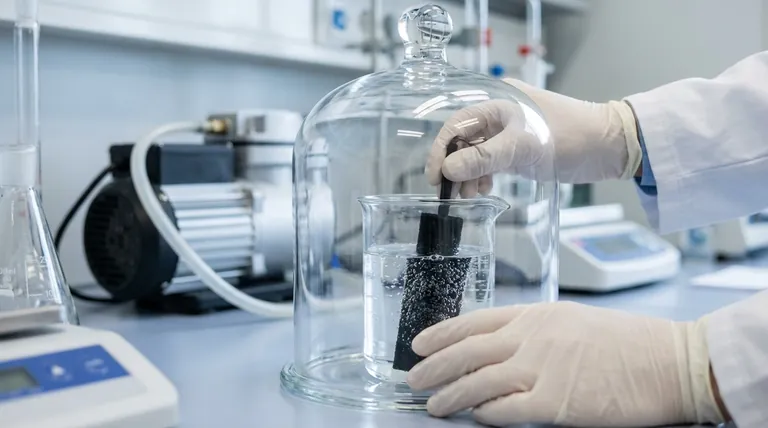The single most critical step when using carbon felt in an experiment is to ensure it is completely immersed and saturated with the electrolyte. You must actively work to eliminate any trapped air bubbles within its porous structure. These bubbles act as insulators, drastically reducing the available surface area for reactions and compromising the efficiency and accuracy of your results.
The core challenge with carbon felt isn't just using it, but activating its full potential. Trapped air renders its vast internal surface area useless, so proper wetting isn't just a preparatory step—it is fundamental to the entire experiment's success.

The Role of Carbon Felt's Unique Structure
To understand why a simple air bubble is so problematic, we must first appreciate why carbon felt is used as an electrode material in the first place.
High Surface Area is the Goal
Carbon felt is not a flat surface. It is a three-dimensional, highly porous matrix of carbon fibers. This structure provides an enormous surface area in a very small volume, which is ideal for electrochemical reactions.
The Critical Three-Phase Boundary
Effective electrochemical reactions happen where the electrode (solid), the electrolyte (liquid), and the reactants meet. This interface is where everything happens.
Why Air Bubbles Are a Critical Failure Point
An air bubble is an insidious problem because it displaces the liquid electrolyte, effectively deactivating large portions of the electrode.
They Create "Dead Zones"
Air is an electrical insulator. When a bubble is trapped within the felt's fibers, it prevents the electrolyte from making contact with the carbon surface. That entire region becomes an inert, non-reactive "dead zone."
They Hinder Mass Transport
In systems with flowing electrolytes, such as flow batteries, bubbles can obstruct the tiny channels within the felt. This blockage prevents fresh reactants from reaching the electrode surface and stops products from being carried away, slowing the entire process.
They Reduce Overall Efficiency
The direct consequence of these dead zones and blockages is a significant drop in performance. Your measurements will show lower currents and slower reaction rates simply because a large fraction of your expensive electrode material is not participating in the reaction.
Understanding the Trade-offs and Best Practices
While its high surface area is a major benefit, the porous nature of carbon felt requires deliberate and careful handling to be effective.
The Challenge of Hydrophobicity
Carbon surfaces can be naturally hydrophobic (water-repelling), which makes it difficult for aqueous electrolytes to penetrate the felt's dense fiber network on their own. This inherent property is what makes bubble removal a non-trivial task.
Best Practice: Pre-Treatment and Wetting
To overcome this, a pre-treatment step is essential. Soaking the felt in a wetting agent like ethanol or isopropanol first can help. The alcohol wets the fibers easily and is then displaced by the electrolyte, pulling the liquid into the pores and pushing air out. For critical applications, placing the felt in electrolyte under a vacuum can physically pull all trapped gas out.
Best Practice: Ensuring Secure Connections
The insights from handling other electrodes apply here as well. Ensure the carbon felt has a secure, low-resistance electrical connection to your apparatus. A poor connection introduces errors that can be mistakenly blamed on the chemical reaction itself.
Best Practice: Verifying Compatibility
Finally, always confirm that your chosen electrolyte is chemically compatible with the carbon felt. While generally inert, aggressive chemistries or extreme potentials can cause the carbon to degrade, destroying the electrode and contaminating your experiment.
Making the Right Choice for Your Goal
Your experimental setup procedure should be guided by your primary objective.
- If your primary focus is maximum reaction efficiency: Your top priority is complete wetting, likely using a vacuum or solvent-exchange method to remove every last air bubble.
- If your primary focus is data accuracy and repeatability: You must standardize a rigorous wetting procedure and ensure a stable, low-resistance electrical connection in every trial.
- If your primary focus is long-term operational stability: You must prioritize confirming the chemical compatibility between the electrolyte and the carbon felt to prevent degradation over time.
Ultimately, treating the preparation and installation of your carbon felt with the same precision as the rest of your experiment is the key to obtaining reliable and meaningful results.
Summary Table:
| Step | Purpose | Best Practice |
|---|---|---|
| Eliminate Air Bubbles | Prevents insulating 'dead zones' and maximizes reactive surface area. | Pre-treat with ethanol or use vacuum degassing. |
| Ensure Secure Connection | Guarantees stable electrical contact for accurate data. | Check for low-resistance connection to apparatus. |
| Verify Chemical Compatibility | Prevents electrode degradation and experiment contamination. | Confirm electrolyte is inert to carbon felt at operating conditions. |
Achieve precise and reliable results in your lab.
Proper electrode preparation is fundamental to experimental success. KINTEK specializes in high-quality lab equipment and consumables, including carbon felt electrodes designed for optimal performance. Our experts can help you select the right materials and implement best practices for your specific application.
Enhance your electrochemical experiments—contact our team today for personalized support and discover how our solutions can drive your research forward.
Visual Guide

Related Products
- Glassy Carbon Sheet RVC for Electrochemical Experiments
- Glassy Carbon Electrochemical Electrode
- Rotating Platinum Disk Electrode for Electrochemical Applications
- Reference Electrode Calomel Silver Chloride Mercury Sulfate for Laboratory Use
- Electrolytic Electrochemical Cell for Coating Evaluation
People Also Ask
- What are the typical physical specifications for glassy carbon sheets? Unlock Superior Performance for Your Lab
- What actions and conditions are strictly prohibited when working with a glassy carbon sheet? Protect Your Investment and Data Integrity
- What general precautions should be taken to maintain the performance and accuracy of a glassy carbon sheet? Ensure Reliable Electrochemical Data
- What is an RVC glassy carbon sheet? A High-Performance Material for Demanding Applications
- What are the fundamental characteristics of glassy carbon? Discover its Unique Synergy of Properties



















